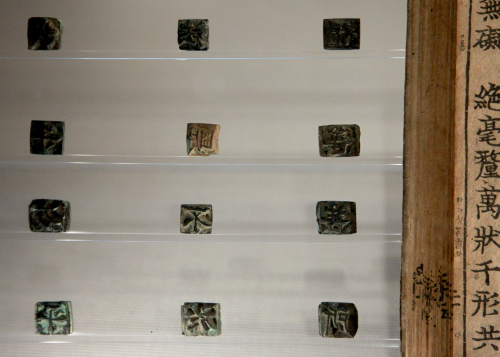Twelve newly-discovered movable metal print types, claimed to be the world’s oldest, went on display at Dabosung Antique in Insa-dong, Seoul, Thursday.
Nam Kwon-Heui, a Kyungpook National University professor who has been researching the print type at the request of Dabosung Antique, concluded that the metal types predate “Jikji,” the UNESCO-designated Korean document that is known as the world’s oldest extant book, by 138 years.
“I have confirmed that these blocks are from the 13th century Goryeo Kingdom period, and had been used for the printing of Nammyeongcheonhwasangsongjeungdoga (Sermons of Buddhist Priest Nam Myeongcheon),” Nam said.

Twelve newly-found metal print types are claimed to be the world’s oldest by Nam Kwon-Heui, a professor at Kyungpook National University and Dabosung Antique in Seoul. On the right is a copy of “Sermons of Buddhist Priest Nam Myeongcheon.” (Yonhap News)
A copy of the same sermons printed using wooden blocks from the Goryeo Kingdom period, designated a national treasure, is currently owned by Samseong Museum of Publishing. Nam, after about three years of extensive research, confirmed that the newly found blocks and the print of the treasure match with one another. “I’d like to call the blocks ‘Jeungdoga-Ja,’ naming them after the treasure,” Nam said.
According to Dabosung Antique, the types are believed to have been taken to Japan during the Japanese colonial era. An unknown private individual purchased the types and brought them back to Korea about 10 years ago. Nam, however, said his job was mainly research. “I’m not sure where they were found,” he said.
If the newly found relics are confirmed to be the world’s oldest movable metal type, they will rewrite history. However, researchers at the National Museum of Korea said it is difficult to confirm the year of origin of metal relics because of their lack of carbon substance which is crucial for the carbon dating process.
“It would possible to find which era they were from if the types were made out of wood,” she said under condition of anonimity. “But metals are diffirent and they are easily affected by rust as well.”
By Claire Lee (clairelee@heraldcorp.com)



![[Grace Kao] Hybe vs. Ador: Inspiration, imitation and plagiarism](http://res.heraldm.com/phpwas/restmb_idxmake.php?idx=645&simg=/content/image/2024/04/28/20240428050220_0.jpg&u=)

![[Herald Interview] Mom’s Touch seeks to replicate success in Japan](http://res.heraldm.com/phpwas/restmb_idxmake.php?idx=645&simg=/content/image/2024/04/29/20240429050568_0.jpg&u=)
